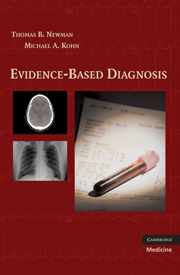Book contents
- Frontmatter
- Contents
- Preface
- Acknowledgments & Dedication
- Abbreviations/Acronyms
- 1 Introduction: understanding diagnosis and diagnostic testing
- 2 Reliability and measurement error
- 3 Dichotomous tests
- 4 Multilevel and continuous tests
- 5 Critical appraisal of studies of diagnostic tests
- 6 Screening tests
- 7 Prognostic tests and studies
- 8 Multiple tests and multivariable decision rules
- 9 Quantifying treatment effects using randomized trials
- 10 Alternatives to randomized trials for estimating treatment effects
- 11 Understanding P-values and confidence intervals
- 12 Challenges for evidence-based diagnosis
- Answers to problems
- Index
- References
11 - Understanding P-values and confidence intervals
Published online by Cambridge University Press: 04 August 2010
- Frontmatter
- Contents
- Preface
- Acknowledgments & Dedication
- Abbreviations/Acronyms
- 1 Introduction: understanding diagnosis and diagnostic testing
- 2 Reliability and measurement error
- 3 Dichotomous tests
- 4 Multilevel and continuous tests
- 5 Critical appraisal of studies of diagnostic tests
- 6 Screening tests
- 7 Prognostic tests and studies
- 8 Multiple tests and multivariable decision rules
- 9 Quantifying treatment effects using randomized trials
- 10 Alternatives to randomized trials for estimating treatment effects
- 11 Understanding P-values and confidence intervals
- 12 Challenges for evidence-based diagnosis
- Answers to problems
- Index
- References
Summary
Introduction
In the previous two chapters, we discussed using the results of randomized trials and observational studies to estimate treatment effects. We were primarily interested in measures of effect size and in problems with design (in randomized trials) and confounding (in observational studies) that could bias effect estimates. We did not spend much time considering the precision of our effect estimates or whether the apparent treatment effects could be a result of chance. The statistics used to help us with these questions − P-values and confidence intervals – are the subject of this chapter.
No area in epidemiology and statistics is so widely misunderstood and mistaught. We cover a more sophisticated understanding of P-values and confidence intervals in this text because 1) it is right, 2) it is important, and 3) we think you can handle it. After all, you have survived three chapters (3, 4, and 8) on using the results of diagnostic tests and Bayes's Theorem to update a patient's probability of disease. So now you are poised to gain a Bayesian understanding of P-values and confidence intervals as well. We will give you a taste in this chapter; those wishing to explore these ideas in greater depth are encouraged to read an excellent series of articles on this topic by Steven Goodman. (Goodman 1999a; Goodman 1999b; Goodman 2001)
- Type
- Chapter
- Information
- Evidence-Based Diagnosis , pp. 220 - 238Publisher: Cambridge University PressPrint publication year: 2009
References
- 1
- Cited by



